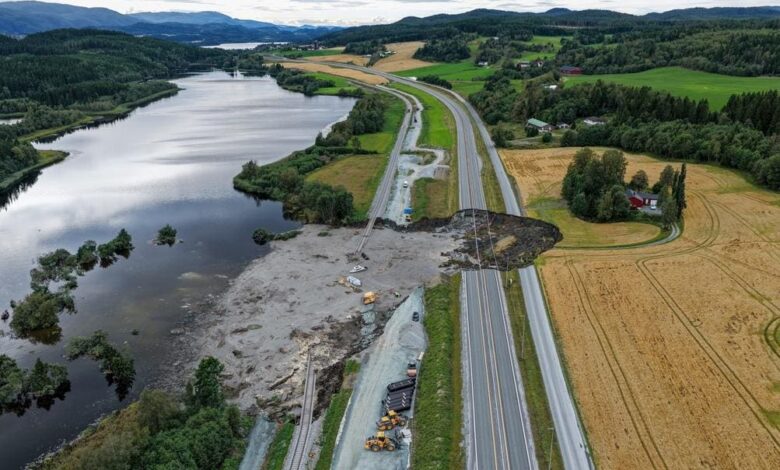Travel Chaos After Landslide Splits Norway In Two

📝 usncan Note: Travel Chaos After Landslide Splits Norway In Two
Disclaimer: This content has been prepared based on currently trending topics to increase your awareness.
The motorway, old road, and railway line were all destroyed by the landslide near Levanger, Norway.
NTB/AFP via Getty Images
On the morning of August 30, a section of Norway’s E6 highway collapsed near Nesvatnet in Levanger after a suspected quick clay landslide. The collapse took with it both lanes of the highway, the alternative road and intercity railway line.
Police since confirmed that one Danish worker is still missing presumed dead after being caught in the landslide. Another person survived after their vehicle was swept into water and was treated at a local hospital.
Authorities stressed that their immediate priority has been the search and rescue operation and the safety of residents in what a police spokesperson described as a “very unstable” area.
Norway’s Main Artery Severed
The E6 is not just another highway. Stretching more than 1,600 miles from southern Sweden to Norway’s far north at Kirkenes, it is the country’s most important north–south road.
In Levanger, around 50 miles north of Trondheim, the highway carries an average of 8,400 vehicles every day, linking commuters, long-distance travelers, and freight operators.
For now, that vital artery has been cut. “This is a dramatic situation for transport through the region, and it will affect many, both businesses and private individuals,” Levanger’s mayor Anita Ravlo Sand said in a statement.
To add to the problems for travelers, the parallel Nordlandsbanen railway line was also destroyed in the slide.
The landslide has severed both lanes of the highway, the old road and the railway line.
NTB/AFP via Getty Images
Bane Nor, which manages Norway’s rail infrastructure, confirmed that extensive work will be required to stabilize the ground before repairs can begin.
Long Detours For Travelers
The closure means long detours for anyone traveling by road between Trondheim and Steinkjer, including tourists planning to drive the scenic Kystriksveien coastal road or those heading toward the Lofoten Islands and northern Norway.
Two main alternatives are recommended by the Norwegian Public Roads Administration:
Via Sweden: East from Trondheim along the E14 through Stjørdal and Meråker, crossing the border into Jämtland before heading north to rejoin the E6 at Verdal. This adds at least 75 miles to the journey and a potential customs check.
Via ferry: Crossing the Trondheimsfjord on the Flakk–Rørvik ferry just outside Trondheim, then continuing north on regional road 755 to reconnect with the E6.
Smaller vehicles can also use the old Kongevei (King’s Road) in Levanger, but authorities have warned that this route is unsuitable for heavy traffic. With limited capacity on the ferry and narrow country roads, congestion is expected.
Rail Passengers Also Face Delays
Train passengers are no better off. Because of planned engineering work, buses were already replacing trains on this stretch of the Nordlandsbanen line. Now, with the track destroyed, it could be much longer before services resume.
Travelers heading north from Trondheim toward Bodø are advised to prepare for long delays. In a statement, train operator SJ Nord said it is “working to plan alternative travel routes.”
Impact On Tourism
Although the immediate priority is recovery, the disruption comes during the late summer season when both domestic tourists and international visitors use the E6 to explore Trøndelag and beyond.
The road is a key link for travelers heading to the fjords, the Lofoten Islands, or even further north to Tromsø and the North Cape.
For anyone planning to travel in central Norway in the coming days, the best advice is to allow plenty of extra time and check the latest updates from the Norwegian Public Roads Administration.
Bus operators are adjusting schedules, while freight companies are warning of significant delays. Tourists renting cars should be prepared for long drives on unfamiliar rural roads, as well as potential long waits for ferries.
It’s also worth checking flights with SAS, Norwegian and Widerøe, although demand and prices are likely to be high.
A Dramatic Day
For tourists on road trips, the incident is a stark reminder of Norway’s dramatic geology.
Quick clay is a type of soil found in central and southern Norway that can appear stable for decades but collapse without warning when disturbed by water, construction, or erosion.
Once it liquefies, the clay loses all strength, turning solid ground into a fluid mass that can swallow houses, roads, and entire landscapes in seconds.
Norway has seen this before. In 2020, a quick clay slide in the town of Gjerdrum killed ten people and destroyed dozens of homes.
MORE FROM FORBES



